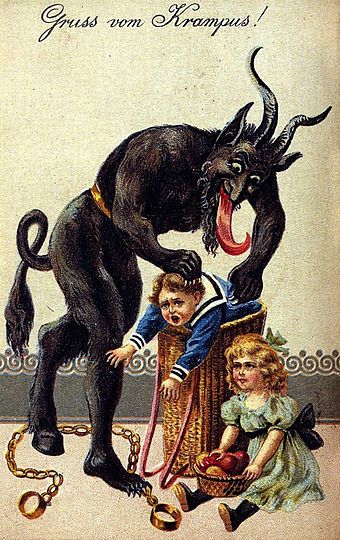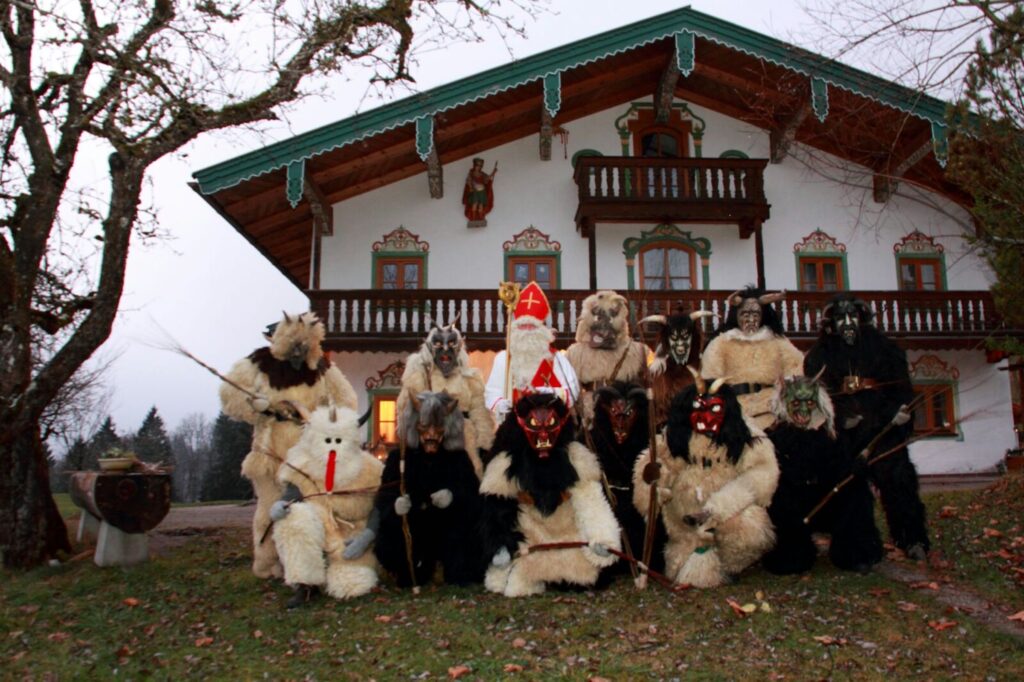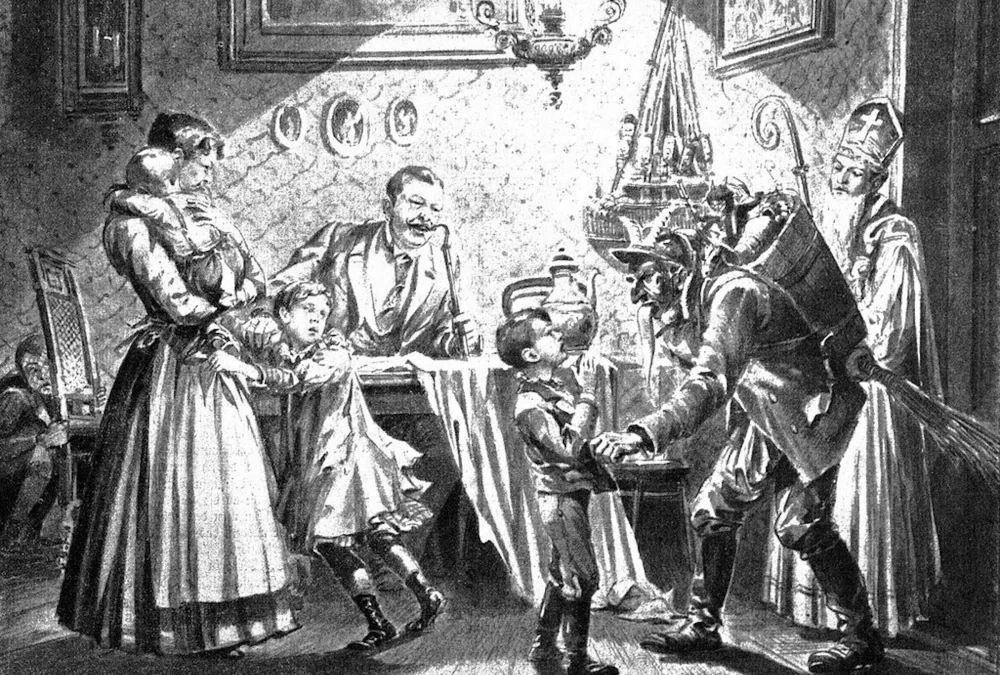Meet the Krampus. This ancient alpine Christmas spirit may be the perfect mascot for 2020. America’s Santa Claus knows if you are naughty or nice. In much of Central Europe, Saint Nicholas still hands out the rewards for good behavior and the naughty part is overseen by this frightening holiday demon.
The Krampus accompanies Saint Nicholas on his gift-giving rounds on the evening of December 5. While St. Nick brings treats to good children, the demon-like Krampus delivers punishment, whacking bad children and the occasional grown-up with his birch-twig switch and encouraging them to behave with the threat of being carried off into the night.
I grew up hearing the story of how my Swiss father’s older brother was singled out and put into the Krampus’ sack when they were small children. The incident terrified both brothers, and remained a vivid memory for my dad. The true horror of the incident didn’t register with me until images of traditional Krampus costumes began to appear on the internet in the late 1990s, featuring towering, shaggy figures wearing masks carved from wood and decorated with animal teeth and horns or antlers.

popular. This festive card from around 1900, showing the old demon gleefully
stuffing a naughty child in his basket, states “Gruss vom Krampus,” greetings from
the krampus.
There are many theories about the origin of the Krampus. Some speculate he is all that is left of one of the Norse gods, perhaps a servant to Odin, the father god, who now accompanies St. Nicholas instead. Others claim that the tradition is more recent and that he is a representation of the Christian devil—horns, hooves, tail and all, a survival from one of the allegorical holiday plays that were popular in medieval times. The most likely theory is that the Krampus is an indigenous alpine nature spirit, a holdover from animist beliefs that predate both Christianity and the Norse gods.
Kurt Lussi is the curator of religious folklore at the Lucerne History Museum in Switzerland. In a 2018 interview for the news service of the Swiss Broadcasting Corporation, he explained that the St. Nicholas custom has become inextricably interwoven with festivals of masks dating back to pre-Christian times.
He says that St. Nicholas’ supernatural helpers, like the Krampus, are “a symbol of the evil spirits which these ancient festivals sought to drive out with a combination of noise and light.”
The Krampus is just one of a motley assortment of alpine spirits who appear during midwinter. Many are associated with St. Nicholas Day, which became a widely celebrated feast day in the alps in the 11th century. Others turn up during the 12 days of Christmas, from December 25 until Epiphany, on January 6. Many of the traditional costumes and characters return again for Carnival, or Fasnacht, on the night before Ash Wednesday.
Variations on the Krampus theme include Switzerland’s Schmutzli, a mysterious figure in a dark cloak and hood who accompanies Samiclaus—the Swiss St. Nick—and who, like the Krampus, is also equipped with a birch twig whip and a sack to carry off bad children; Père Fouettard in France, who accompanies Père Noël; Knecht Ruprecht, a more benign version of Schmutzli, who is servant and companion to the saint throughout much of German-speaking Europe; and Belsnickel, a solitary spirit from the Rhine region of Germany, who dispenses punishment and Christmas treats on his own.
Belsnickel crossed the ocean to America, accompanying German immigrants to Pennsylvania and Maryland in the 18th century. For a long time he was the only European Christmas demon in residence in the U.S. The Krampus arrived in the late 20th century, traveling not with immigrants but via the Internet.
In America, Saint Nick was co-opted by the Coca Cola company in 1931, and diminished from a benevolent saint to a corpulent corporate trademark. The Krampus has so far retained his mythological integrity, perhaps because his commercial potential is limited by his fearsome and demonic appearance. He has also survived numerous eclesiastical and governmental attempts to stamp out the custom over the centuries.
The Krampus’ low point may have been his Hollywood debut in a horror film in 2015. The plot, critics charged, missed the point of the krampus tradition. Instead of being the shadow cast by the saint, he was instead portrayed as a demonic anti-Santa Claus. But this adaptable and enduring spirit has also survived decades of being depicted in lurid greeting cards with no ill effect. Instead of fading or becoming the subject of saccharine TV specials, the Krampus continues to gain popularity, and there’s a concerted effort to keep the tradition alive.
In 2015, officials in the village of Virgen in Austria worried that newly arrived immigrants from war-torn Syria and Iraq would be frightened of the Krampus tradition.
A news story reported that community representatives visited the migrant families, bringing Krampus masks to show the new arrivals’ children. They explained the custom with the help of a translator, so the town’s 22 newest residents would understand and be able to enjoy the festivities without being frightened, or without being frightened any more than usual about the presence of larger-than-life monsters with horns and whips and torches and bells.
In 2013, Krampus Los Angeles, a local troop of traditionally costumed performers, brought the custom to Southern California, and groups are springing up all over the U.S., from Seattle, Washington, to Bloomington, Indiana.
Al Ridenour is one of the founding members of Krampus LA and the author of The Krampus and the Old, Dark Christmas: Roots and Rebirth of the Folkloric Devil, a book that is the product of extensive research into the Krampus and related traditions in Europe. For him the appeal of the Krampus is in its authenticity.
“He is the real thing, not encountered in a digitally encoded storyline, but in a million unpredictable living interactions,” Ridenour writes. “It is precisely those living horns-and-fur encounters that make this figure so compelling…whether we laugh or scream, at least we know we are now truly awake, experiencing the real world fully, and standing before a myth.”


attendants that include a hobby horse, is from a Prague newspaper, dated 1910. Image courtesy of Wikimedia Commons





